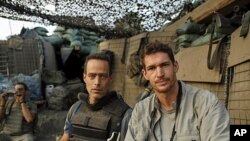The documentary Restrepo shows the reality of war through the experience of one American platoon in Afghanistan. Our correspondent spoke with producers Sebastian Junger and Tim Hetherington about the film and the soldiers it depicts.
Violence was a daily part of life for this 15-man platoon on their deployment in the Korengal Valley of eastern Afghanistan in 2007 and 2008.
The film opens with the blast of an IED, an improvised explosive device, experienced with the soldiers from inside an armored vehicle.
Author Sebastian Junger, who wrote the best-selling book The Perfect Storm, says the film does not make any judgments.
"We wanted to make a film that for the audience that would be a completely visceral experience of war, of being in combat with soldiers," said Junger. "Soldiers do not debate the wider political questions while they are fighting. They just do not."
The documentary follows the members of Second Platoon, Battle Company, 173rd Airborne Brigade Combat Team as they build a mountain outpost in the heart of Taliban territory.
They name it Restrepo, after a fallen comrade, Juan Restrepo. The 20-year-old medic was killed early in the deployment.
These men adapted to a brutal reality, says filmmaker Hetherington.
"You can say that war abases, it perverts things, but at the same time, war also humanizes you," said Hetherington. "That is something that also people have difficulty understanding."
The producers each operated a handheld camera, capturing images of violent Taliban attacks, intervening hours of boredom, and tense weekly meetings with local villagers. Junger says the film shows the uncertainty, fear and camaraderie that soldiers face in wartime.
"From war to war, from century to century, I do not think it changes much," he said. "It is the experience of young men facing death and protecting each other. I think there is an essential component of that that really does not change very much."
The producers say the film is neither anti-war nor pro-war, and Hetherington says that through it, civilians see the experience of troops in frontline combat.
"We both felt that Americans, people back home, need to fully grasp what they are asking these young men to do when they send them to war," he said. "They need to understand that reality. And we want our film to be a bridge between the public and what soldiering is like."
He says that may lead to a better informed conversation about the costs and benefits of the war.
Critics have praised the film as a stark and gripping portrait. Some have complained that it offers only glimpses of the Afghan experience seen from an American perspective. Hetherington and Junger admit that much about the war was beyond their scope, and say the purpose of the film is to tell the soldiers' story.
Documentary 'Restrepo' Shows War Through Eyes of American Soldiers









